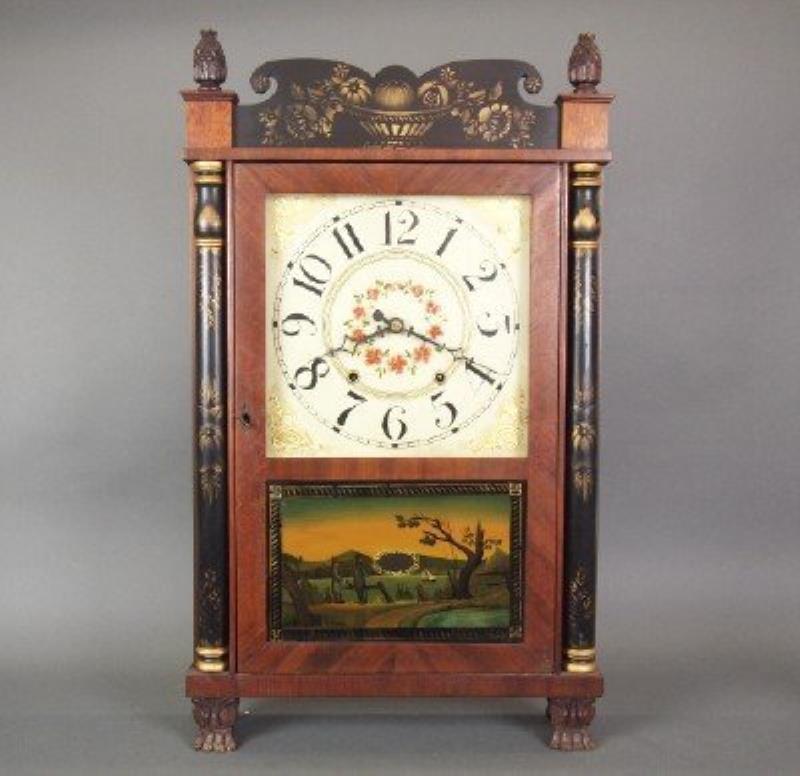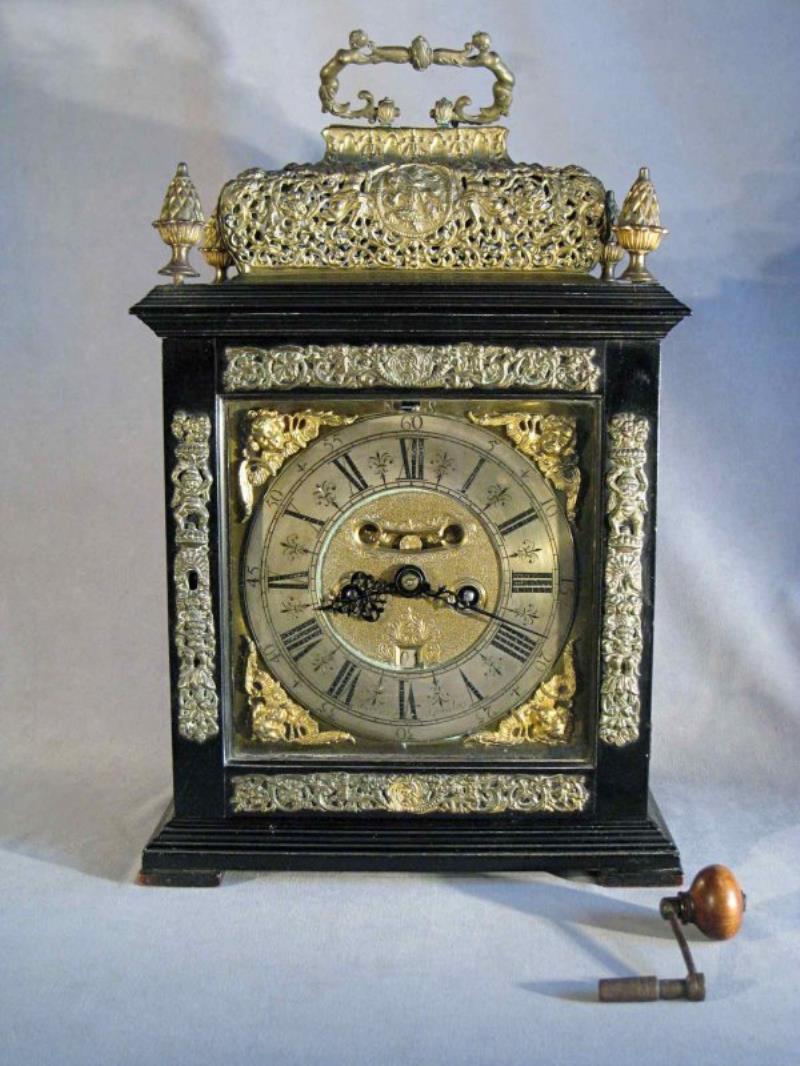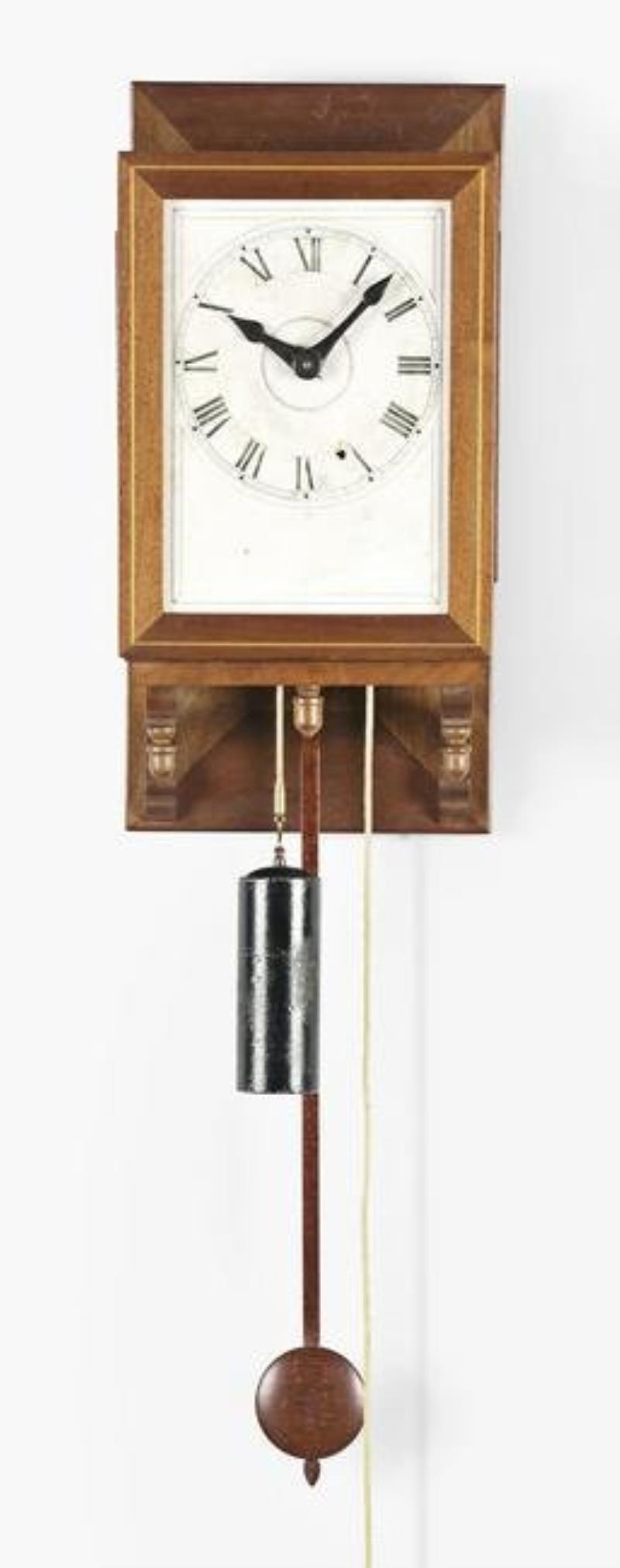Important Charles Smith Hanging Clock
- Estimate:
- [restrict paid=ture]$1,000 – $1,500[/restrict]
- Auctioneer:
- [restrict paid=ture]Schmitt Horan & Co.[/restrict]
- Sold Price:
- [restrict paid=ture]$950[/restrict]
- Sold Date:
- [restrict paid=ture]Nov 20, 2022[/restrict]
Charles Alvah Smith, Brattleboro, Vermont hanging clock, serial #2 of 612 total made, in a rectilinear walnut case with string inlay and raised panels on sides, roman numeral paper dial with ebony hands, 8 day, time only, weight driven wooden movement with wooden pendulum rod, bob and mounting bracket, signed in pencil on dial frames "Made by Charles Alvah Smith, Brattleboro, Vt No. 2" and "New Movement made March, 1933, New face Feb. 1938", signed on movement "#320 movement"
Important Charles Smith Hanging Clock

- Estimate:
- [restrict paid=ture]$1,000 – $1,500[/restrict]
- Auctioneer:
- [restrict paid=ture]Schmitt Horan & Co.[/restrict]
- Sold Price:
- [restrict paid=ture]$950[/restrict]
- Sold Date:
- [restrict paid=ture]Nov 20, 2022[/restrict]
Charles Alvah Smith, Brattleboro, Vermont hanging clock, serial #2 of 612 total made, in a rectilinear walnut case with string inlay and raised panels on sides, roman numeral paper dial with ebony hands, 8 day, time only, weight driven wooden movement with wooden pendulum rod, bob and mounting bracket, signed in pencil on dial frames "Made by Charles Alvah Smith, Brattleboro, Vt No. 2" and "New Movement made March, 1933, New face Feb. 1938", signed on movement "#320 movement"
Charles Smith Hanging Clock

- Estimate:
- [restrict paid=ture]$800 – $1,200[/restrict]
- Auctioneer:
- [restrict paid=ture]Schmitt Horan & Co.[/restrict]
- Sold Price:
- [restrict paid=ture]$700[/restrict]
- Sold Date:
- [restrict paid=ture]Nov 20, 2022[/restrict]
Charles Alvah Smith, Brattleboro, Vermont hanging clock, serial #561 of 612 total made, in a rectilinear tiger maple case with string inlay and glazed sides, roman numeral paper dial with tiger maple hands, 8 day, time only, weight driven wooden works movement with wooden pendulum rod, bob and mounting bracket and tiger maple sheathed weight, stamped on case "Apr. – 1945 and "Chas. A. Smith, Canal St. Brattleboro No. 561" with movement stamped "562"
Charles Smith Hanging Clock

- Estimate:
- [restrict paid=ture]$800 – $1,200[/restrict]
- Auctioneer:
- [restrict paid=ture]Schmitt Horan & Co.[/restrict]
- Sold Price:
- [restrict paid=ture]$700[/restrict]
- Sold Date:
- [restrict paid=ture]Nov 20, 2022[/restrict]
Charles Alvah Smith, Brattleboro, Vermont hanging clock, serial #561 of 612 total made, in a rectilinear tiger maple case with string inlay and glazed sides, roman numeral paper dial with tiger maple hands, 8 day, time only, weight driven wooden works movement with wooden pendulum rod, bob and mounting bracket and tiger maple sheathed weight, stamped on case "Apr. – 1945 and "Chas. A. Smith, Canal St. Brattleboro No. 561" with movement stamped "562"
Wall Clock by Charles Alva Smith

- Estimate:
- [restrict paid=ture]$250 – $500[/restrict]
- Auctioneer:
- [restrict paid=ture]Converse Auctions[/restrict]
- Sold Price:
- [restrict paid=ture]$1,100[/restrict]
- Sold Date:
- [restrict paid=ture]1:00 PM – Jun 18, 2010[/restrict]
A finely made 13″ weight driven wall timepiece with wooden gears attributed to Charles Alva Smith (American) together with book about the maker.
Smith, Tuttle & Blakeslee shelf clock

- Estimate:
- [restrict paid=ture]$300 – $500[/restrict]
- Auctioneer:
- [restrict paid=ture]Schmidt's Antiques Inc. Since 1911[/restrict]
- Sold Price:
- [restrict paid=ture]$300[/restrict]
- Sold Date:
- [restrict paid=ture]8:00 AM – Sep 12, 2015[/restrict]
A 19th century Smith, Tuttle & Blakeslee shelf clock. 30 hr time and strike weight driven wooden movement with painted wooden dial. Mahogany case with shaped stenciled crown and carved Pineapple finials above a single door with clear and reverse painted lower glasses, flanked by stenciled half columns on carved paw feet. Older refinishing in good condition, minor wear. 30″ high.
Condition
Important Bracket Clock by Markwick

- Estimate:
- [restrict paid=ture]$4,000 – $10,000[/restrict]
- Auctioneer:
- [restrict paid=ture]Converse Auctions[/restrict]
- Sold Price:
- [restrict paid=ture]$4,000[/restrict]
- Sold Date:
- [restrict paid=ture]1:00 PM – Jun 18, 2010[/restrict]
A late 17th or early 18th century bracket or table clock signed “Markwick, London”. The Markwick family is known as one of the earliest of LondonÂs clockmakers, with James Markwick being succeeded by James, presumably his son. The second James Markwick ascended into the Clockmakers Company of London in 1692, becoming a master in 1720, and it was he who sometimes signed his work as simply ÂMarkwick like this example. This clock is late 17th or early 18th century.
Since the first clocks needed hanging weights to run, they had the problem of not being portable. Certainly one of the major advances in clock making in the late 1600s was the development of coiled mainsprings to drive the clock, making it possible to greatly reduce the clock’s size and weight- making them portable. So these mainspring driven Âbracket or Âchamber or Âtable clocks were ordinarily carried from room to room throughout the day by the handles mounted on top. Table clocks would run even if placed on the slightly un-level surface of a table or the floor; the feature of a Ârepeat device (such as this example once had) would allow its insomniac owner to pull the clockÂs night cord on his clock on the floor near the bed to hear the hours rung out at night when it was too dark to see the dial.
The first bracket clocks appeared in the late 1600s and were considered rare even in their own time, being something only those only the wealthiest could afford. Throughout the 18th century style changes were made to the mechanisms, dials and cases giving antiquarians a chance to date them with confidence. In addition to the dial signature, this example features a number of style examples that allow us to confirm its early 18th century date and London, England origin: a square engraved dial with a Âfalse pendulum aperture; a highly decorated and engraved backplate; an ebonized oak case; the patterns of the blued steel hands; the gilded Âangel spandrels; and the Âbasket top feature, whose top is made from a pierced, chaste, and engraved bronze frame instead of wooden moldings.
A word on the term Âbasket topÂ. A basket top was a less than usual stylistic feature for bracket clocks confined to early 18th century examples. Our example has lost its gilded (gold) or silvered surface as have the repousse door mounts. The basket features a central St George trampling and spearing the dragon below him. The engraved back plate is of top quality with a pattern of flowing, flowering tulips, an influence of the Dutch whose clockmakers worked closely with their English partners during this period. The anchor escapement is an early conversion from the original crown wheel escapement; the four pineapple finials are later.
This early bracket clock comes to us with a provenance of having been through three generations without substantial restorations. It was purchased in the 1920s, and kept time in the offices of Industrialist Roy D. Chapin, Secretary of Commerce during the Hoover Administration. After that it was displayed in the library of the renowned Grosse Pointe Farms, Michigan. Its lack of restorations for three generations is something sophisticated collectors appreciate: most prefer acquiring items of art and antiquity in Âas found condition, an assurance that there are no hidden restorations.
 ClockPrices.Com
ClockPrices.Com



